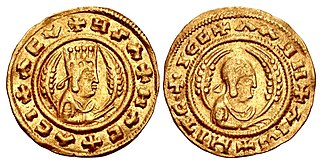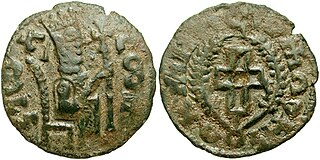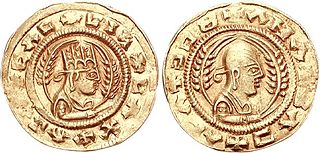| Hataz | |
|---|---|
 | |
| King of Aksum | |
| Predecessor | Ioel |
| Successor | Saifu |
Hataz (c. 575) was a King of the Kingdom of Aksum. He is primarily known through the coins that were minted during his reign, some of which call him "Iathlia".
| Hataz | |
|---|---|
 | |
| King of Aksum | |
| Predecessor | Ioel |
| Successor | Saifu |
Hataz (c. 575) was a King of the Kingdom of Aksum. He is primarily known through the coins that were minted during his reign, some of which call him "Iathlia".

Axum, or Aksum, is a town in the Tigray Region of Ethiopia with a population of 66,900 residents.

D mt was a kingdom located in Eritrea and northern Ethiopia that existed between the 10th and 5th centuries BC. Few inscriptions by or about this kingdom survive and very little archaeological work has taken place. As a result, it is not known whether Dʿmt ended as a civilization before the Kingdom of Aksum's early stages, evolved into the Aksumite state, or was one of the smaller states united in the Kingdom of Aksum possibly around the beginning of the 1st century.

The Obelisk of Axum is a 4th-century CE, 24-metre (79 ft) tall phonolite stele, weighing 160 tonnes, in the city of Axum in Ethiopia. It is ornamented with two false doors at the base and features decorations resembling windows on all sides. The obelisk ends in a semi-circular top, which used to be enclosed by metal frames.

Ezana was ruler of the Kingdom of Aksum, an ancient kingdom located in what is now Eritrea and Ethiopia.. He himself employed the style "king of Saba and Salhen, Himyar and Dhu-Raydan". Tradition states that ‘Ezana succeeded his father Ella Amida (Ousanas) as king while still a child but his mother, Sofya then served as regent until he came of age. He conquered the Kingdom of Kush around the year 350 AD.

Abraha, also known as Abrahah al-Ashram, was an Aksumite army general, then the viceroy of South Arabia for the Kingdom of Aksum, and later declared himself an independent King of Himyar. Abraha ruled much of present-day Arabia and Yemen from around 531–547 CE to around 555–570 CE.

The Zagwe dynasty was an Agaw medieval dynasty that ruled the northern parts of Ethiopia and Eritrea, after the historical name of the Lasta province. Centered at Roha, it ruled large parts of the territory from approximately 900 to 1270 CE, when the last Zagwe King Za-Ilmaknun was killed in battle by the forces of the Amhara King Yekuno Amlak. The name of the dynasty is thought to derive from the ancient Ge'ez phrase Ze-Agaw, meaning "of the Agaw", in reference to the Mara Tekle Haymanot, the founder of the dynasty. Zagwe's best-known King was Gebre Mesqel Lalibela, who is credited with having constructed the rock-hewn monolithic churches of Lalibela.

Kaleb, also known as Saint Elesbaan, was King of Aksum, which was situated in modern-day Eritrea and Ethiopia.
GDRT was a King of the Kingdom of Aksum, known for being the first king to involve Axum in the affairs of what is now Yemen. He is known primarily from inscriptions in South Arabia that mention him and his son BYGT. GDRT is thought to be the same person as GDR, the name inscribed on a bronze wand or sceptre that was found in an area near Atsbi and Dar'a/Addi-Galamo in northern Ethiopia.
ʽDBH [probably vocalized ʽAzaba or ʽAdhebah] was a king of Aksum, in the territory of modern-day North Ethiopia and Eritrea, who ruled c. 230–240. He and his son GRMT are known through South Arabian inscriptions which mention Shamir, king of Dhu-Raydan and Himyar asking for his help against the Sabaean kings.

Wazeba, vocalized by historians as Wazeba, or WZB was a Negus of the Kingdom of Aksum, centered in the highlands of modern Ethiopia and Eritrea. He succeeded Aphilas. Wazeba is known only from the coins that he minted during his reign. He was the first Aksumite ruler to engrave the legends of his coins in Ge'ez, and the only King of Aksum to use that language on his gold currency. S. C. Munro-Hay suggests that the scarcity of Wazeba's coins may hint at a short reign.

Armah or Aṣḥamah, commonly known as Najashi, was the ruler of the Kingdom of Aksum who reigned from 614–631 CE. He is primarily known through the coins that were minted during his reign. It is agreed by Islamic scholars that Najashi gave shelter to the Muslim emigrants around 615–616 at Axum.

Habesha peoples is an ethnic or pan-ethnic identifier that has been historically employed to refer to Semitic language-speaking and predominantly Orthodox Christian peoples found in the highlands of Ethiopia and Eritrea between Asmara and Addis Ababa and this usage remains common today. The term is also used in varying degrees of inclusion and exclusion of other groups.

Aksumite currency was coinage produced and used within the Kingdom of Aksum centered in present-day Eritrea and Ethiopia. Its mintages were issued and circulated from the reign of King Endubis around AD 270 until it began its decline in the first half of the 7th century. During the succeeding medieval period, Mogadishu currency, minted by the Sultanate of Mogadishu, was the most widely circulated currency in the Horn of Africa.

Tigray Province, also known as Tigre, was a historical province of northern Ethiopia that overlayed the present day Afar and Tigray regions. Akele Guzai borders with the Tigray province. It encompassed most of the territories of Tigrinya-speakers in Ethiopia. Tigray was separated from the northern Tigrinya speaking territories by the Mareb River, now serving as the state border to Eritrea, with the Tekezé River separating it from the Amhara dominated south.
The Book of Axum is the name accepted since the time of James Bruce in the latter part of the 18th century CE for a collection of documents from Saint Mary's Cathedral of Axum providing information on Ethiopian history. The earliest parts of the collection date to the mid-15th century during the reign of Zar'a Ya`qob.

The ancient history of Yemen is especially important because Yemen is one of the oldest centers of civilization in the Near East. Its relatively fertile land and adequate rainfall in a moister climate helped sustain a stable population, a feature recognized by the ancient Greek geographer Ptolemy, who described Yemen as Eudaimon Arabia meaning Fortunate Arabia or Happy Arabia. Between the eighth century BCE and the sixth century CE, it was dominated by six main states which rivaled each other, or were allied with each other and controlled the lucrative spice trade: Saba', Ma'īn, Qatabān, Hadhramaut, Kingdom of Awsan, and the Himyarite Kingdom. Islam arrived in 630 CE and Yemen became part of the Muslim realm.
The provinces of Eritrea existed since pre-Axumite times and became administrative provinces from Eritrea's incorporation as a colony of Italy until the conversion of the provinces into administrative regions. Many of the provinces had their own local laws since the 13th century.
Salama or Salamah may refer to:

The Kingdom of Aksum, also known as the Kingdom of Axum or the Aksumite Empire, was a kingdom centered in Northeast Africa and South Arabia from Classical antiquity to the Middle Ages. Based primarily in what is now northern Ethiopia, and spanning modern-day Eritrea, northern Djibouti, and eastern Sudan, it extended at its height into much of southern Arabia during the reign of King Kaleb.

The Tigrinya people, also known as Tigrigna, are an ethnic group native to Eritrea. They speak the Tigrinya language. There also exists a sizable Tigrinya community in the diaspora.